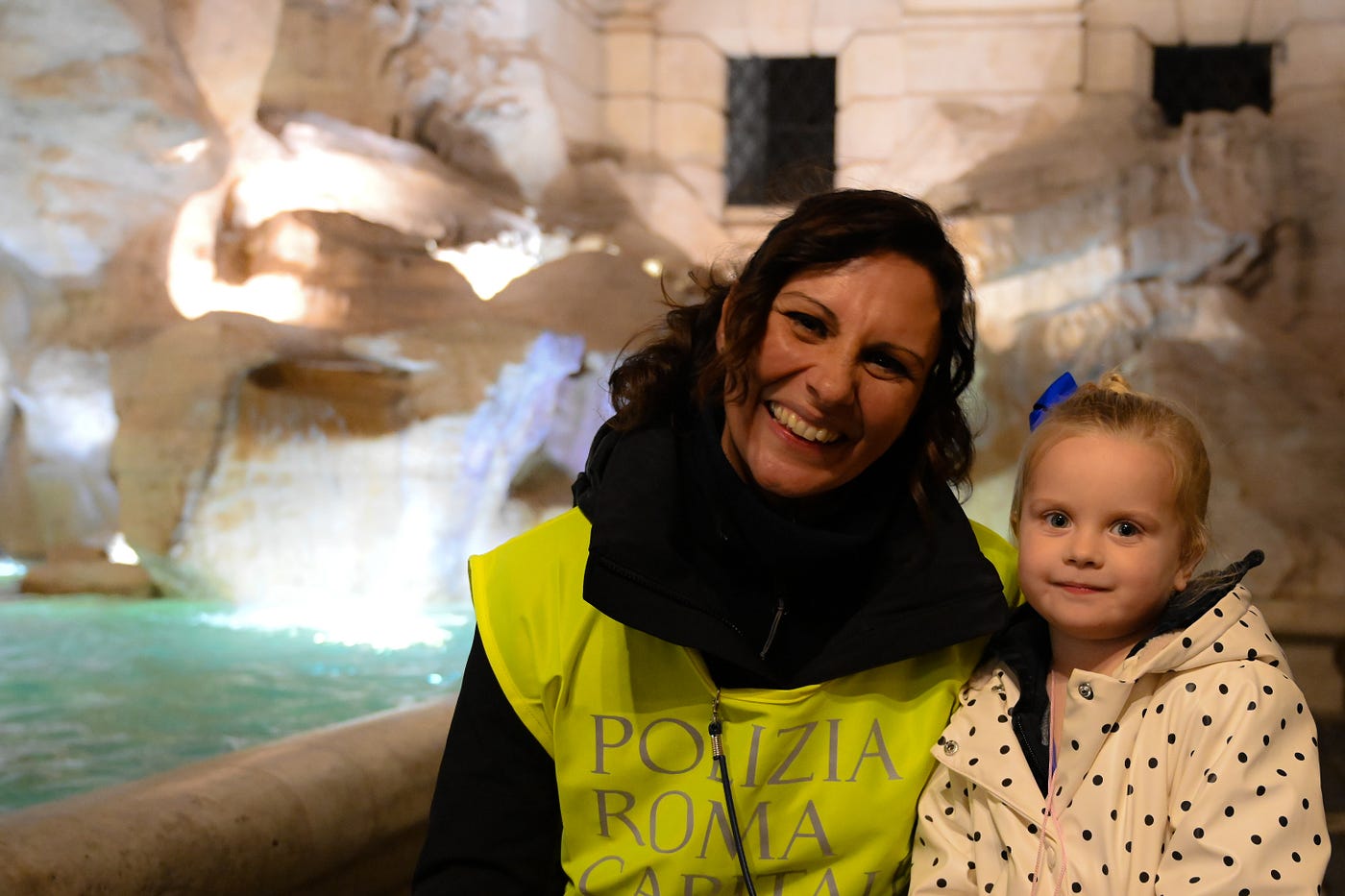Her eyes lit up, sparkling with excitement as we stepped up to Trevi Fountain, soaring 85 feet tall. The night sky was dark, but Rome was pumping with life. The intricately carved travertine statues of the Roman god Neptune, and his water horses, took our breath away.
The crowd around the fountain buzzed with excitement to be sitting at this awe-inspiring Roman landmark. My daughter, three-year-old Peyton, had pressed her small self up against the marble semicircle surrounding the fountain and before even a minute had passed, she simply couldn’t resist it any longer. She dipped her tiny hand into the turquoise blue water.
A shrill whistle pierced through the night air, and the crowd fell silent for a moment. “Non toccare l’acqua!” came a voice beside us.
Peyton was smiling even as she looked up to find a green-vested Polizia Roma staring down at her. The police officer motioned toward Peyton’s wet hand with a disapproving look.
“No!” she said to Peyton again, before she walked away briskly.
But Peyton wasn’t concerned about being scolded. Her eyes were on that bright, shiny whistle.

She watched the police officer walking around the fountain, sternly repeating the orders to many other tourists who, unbeknownst to them, had broken one of the secret rules about what they could and couldn’t do at Trevi Fountain.

Peyton’s eyes never left that silver whistle. She appeared to be deep in thought.
Suddenly, she reached into her sister’s bag and clasped her fingers around a little keychain whistle her sister had purchased in front of the Vatican that morning.
Then Peyton motioned that I should follow her. I was curious, so I followed. She started walking determinedly around the edge of the fountain, blowing the silver keychain whistle with one hand on her hip and the other hand pointing to people while yelling at them.
“No kissing at Trevi Fountain!” she barked at a Chinese couple who were lip-locked, lost in the romance of the city. They stopped kissing and started laughing, embarassed.
“No eating at Trevi Fountain!” she yelled to an American looking tourist who was contentedly eating a slice of pizza. He paused mid-bite, and looked at her with wide, surprised eyes.
“No sitting on Trevi Fountain!” she shouted to a stylish lady who perched elegantly on the edge of the fountain while speaking French into her phone. She tilted her head, amused, then stepped away from the fountain.
“No games at Trevi Fountain!” she said sternly to two Kenyan boys who were tossing a ball back and forth to each other. They caught the ball and stared after her.
“No! No! No!”
Her three-year-old little face was so serious and she blew the whistle hard, pointing and marching. It was her best attempt at mimicking the officer.


At first, I was embarrassed, and tried to get her to stop. But I soon realized that she wasn’t making fun of the police officer. She actually respected her and wanted to imitate her! The crowd saw that too, and soon everyone was roaring with laughter.
People from all over the world were laughing hysterically at Peyton’s unexpected antics. Chinese, Germans, Brazilians, French, Japanese, South Africans — they were equally amused that this tiny little blue-eyed beauty with a shock of white-blond hair was imitating the dark-haired polizia so effectively.

Just before the end of the fountain, Peyton had caught up to the guard who had scolded her, and Peyton was still blowing the whistle, pointing, and shouting at groups of people.
The police officer turned around and faced off with Peyton, her arms folded. Her whistle hung from her lips, and Peyton’s did too. They stared at each other for a moment.
Then the officer burst into laughter, taking off her green vest and wrapping Peyton in it for a moment. She shook Peyton’s little hand, as if congratulating her on her new job as mini-guard of the Roman icon.


Our shy little Peyton had surprised us all and instantaneously won the hearts of the crowd at Trevi Fountain. Step aside, Anita Ekburg (Film: La Dolce Vita), Peyton became the new Trevi Fountain queen that night!

THE HISTORY OF THE FOUNTAIN
Trevi Fountain has a fascinating history which goes back to 19 B.C. when it was the Aqua Virgo Aqueduct, giving water to ancient Rome. It was the source of water which supplied both the Roman Baths and the many fountains scattered throughout the city center.
It was built at the point where three roads meet, giving it the name tre vie (three roads). This developed into the name Trevi, meaning the Three Street Fountain.
The current fountain was designed by Nicola Salvi and was opened in 1762, featuring a statue of the sea god Neptune. He rides on a chariot shaped like a shell that is led by two horses — one calm and one wild. The horses represent the unpredictability of the sea. Salvi had the fountain built out of travertine stone.
The fountain is one of the most iconic sites in Rome, and one of the most beautiful. It has been featured in many films such as La Dolce Vita, Roman Holiday, Three Coins in the Fountain, The Lizzie McGuire Movie, and others.
COIN TOSS TRADITION
It is tradition to toss a coin over your left shoulder with your right hand into the fountain. It is believed that you will: find love in Rome or that you will get to return to Rome one day. It’s worth a try, right?
TRAVEL TIP
– Janelle Schroy
When you visit Rome with kids, be sure to visit the Trevi Fountain, and bring sketchbooks and pencils and take time for the kids to draw the icon while telling them about the history of this important Roman landmark.


